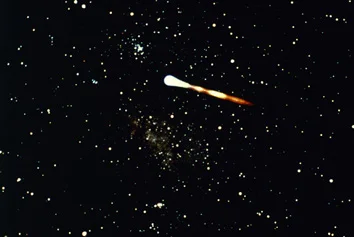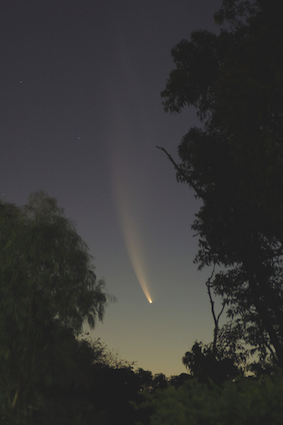Comets move around the sun.
They are made of gas, ice and dust.
Some comets have a long tail made of dust and gas.
You need a telescope to see most comets.
Asteroid vs. Comet
© iStock
Asteroids are made up of metals and rocky material, while comets are made up of ice, dust and rocky material. Both asteroids and comets were formed early in the history of the solar system about 4.5 billion years ago.
Comets orbit around the sun between the planets.
The gases in a comet include carbon dioxide, methane and ammonia.
Most comets can only be seen through a telescope.
Some comets have long, shining tails. The force of light from the sun pushes dust and gas away from the comet to make the tail. Light from the sun makes the tail glow.
The longest comet tail ever measured was recorded in1843. It was 330 million kilometres long.
The centre of a comet is made of frozen gas and ice mixed with dust. It is called the nucleus.
Around the nucleus is the coma, which is made of dust and gas. The coma evaporates when the comet approaches the sun.
Comets are invisible until the come close to the sun.© iStock
Most comets are seen only once because they are pulled towards the sun by its gravity, and then disappear into outer space.
Some comets are trapped by the sun's gravity and stay in orbit around the sun.
Scientists believe that comets are left over material from when the solar system was being formed over 4.6 billion years ago.
Halley's Comet
Halley's comet. Due back in 2016.
Halley's Comet is the most famous comet, but it can only be seen from Earth every 75 - 76 years. It is named after an English astronomer, Edmond Halley, who in 1705 worked out that the comet would appear every 75 - 76 years. It was photographed from spacecraft when it appeared in 1986. It is expected again in 2061.
C/2022 E3 (ZTF)
In late 2022 and early 2023 comet C/2022 E3 (ZTF), nicknamed ‘the green comet,’ came close enough to be seen with the naked eye or with binoculars. Its bright green glow is due to the effect of sunlight on the diatomic carbon and cyanogen of its nucleus. The orbit of this comet is 50,033 years, so the last time it came close to Earth was the time of the early humans, homo sapiens from whom we are descended.
It’s a good idea to get information from more than one source!
Watch a video showing comet C/2022 E3 (ZTF) as it passed Earth in 2022/23
https://www.youtube.com/watch?v=E_N1rHQU0sY
Watch a video from Living Cosmos: Thanks Anton!
Read more about Halley's comet
http://www.space.com/19878-halleys-comet.html





